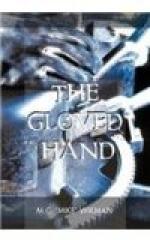Finally, the coroner dipped once more into the suit-case, brought out another bundle and unrolled it. It proved to be a white robe with red stains about the top. He handed it to Simmonds.
“Can you identify this?” he asked.
“Yes,” said Simmonds; “it is the garment worn by Mr. Vaughan at the time of his murder.”
“How do you identify it?”
“By my initials in indelible ink, on the right sleeve, where I placed them.”
“There are stains on the collar of the robe. What are they?”
“Blood-stains.”
“Human blood?”
“Yes, sir.”
“How do you know?”
“I have had them tested.”
“Did any blood come from the corpse?”
“No, sir; the skin of the neck was not broken.”
“Where, then, in your opinion, did this blood come from?”
“From the murderer,” answered Simmonds, quietly.
There was a sudden gasp from the reporters, as they saw whither this testimony was tending. I glanced at Swain. He was a little paler, but was smiling confidently.
Goldberger, his face hawklike, stooped again to the suit-case, produced a third bundle, and, unrolling it, disclosed another robe, also of white silk. This, too, he handed to Simmonds.
“Can you identify that?” he asked.
“Yes,” said Simmonds. “It is the robe worn by Miss Vaughan on the night of the tragedy. My initials are on the left sleeve.”
“That also has blood-marks on it, I believe?”
“Yes, sir;” and, indeed, we could all perceive the marks.
“Human blood?”
“Yes, sir. I had it tested, too.”
“That is all,” said Goldberger, quickly, and placed on the stand the head of the Identification Bureau.
“Mr. Sylvester,” he began, “you have examined the marks on these garments?”
“Yes, sir.”
“What did you make of them?”
“They are all unquestionably finger-marks, but most of them are mere smudges. However, the fabric of which these robes are made is a very hard and finely-meshed silk, with an unusually smooth surface, and I succeeded in discovering a few marks on which the lines were sufficiently distinct for purposes of identification. These I have photographed. The lines are much plainer in the photographs than on the cloth.”
“Have you the photographs with you?”
“I have,” and Sylvester produced them from a pocket. “These are the prints on the robe belonging to the murdered man,” he added, passing four cards to the coroner. “You will notice that two of them show the right thumb, though one is not very distinct; another shows the right fore-finger, and the fourth the right middle-finger.”
“You consider these plain enough for purposes of identification?”
“Undoubtedly. Any one of them would be enough.”
Goldberger passed the photographs to the foreman of the jury, who looked at them vacantly.




